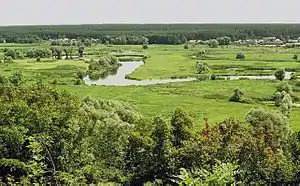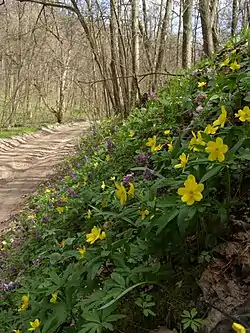Homilsha Woods National Nature Park
Homilsha Woods National Nature Park (Ukrainian: Національний природний парк «Гомільша́нські ліси») is a national park of Ukraine that covers established forests in the Donets River valley. The site has been a protected area for a very long time, beginning with Peter the Great designating local territory as a 'protected ship grove' for wood to build ships. The site also has high ecological value as forest-steppe land. Administratively, the park is in the Zmiiv District of Kharkiv Oblast, about 50 km south of the regional city of Kharkiv.[1]
| Homilsha Woods National Nature Park | |
|---|---|
| Ukrainian: Національний природний парк «Гомільша́нські ліси» | |
IUCN category II (national park) | |
 Homilsha Woods National Nature Park | |
 Location of Park | |
| Location | Zmiiv Raion, Kharkiv Oblast |
| Coordinates | 49°35′N 36°20′E |
| Area | 14,314 hectares (35,371 acres; 143 km2; 55 sq mi) |
| Established | 2004 |
| Governing body | Ministry of Ecology and Natural Resources (Ukraine) |
| Website | http://www.gomilsha.org.ua/jupgrade/index.php |
Topography
The park is composed of a series of protected and recreational areas along both banks of the middle reaches of the Donets River and the Gomolshy River. The right banks of the river is hilly spurs of the Middle Russian Uplands, ranging up to 100 meters above the river. The left bank is generally flat plain of the East European Plain[1] Included on the grounds are many archaeological sites and monuments of historical importance from all eras of Ukrainian history, from the Bronze Age (second millennium BC) to the time of Kyivan Rus.
Climate and ecoregion
The Homilsha Woods area has a Humid continental climate, warm summer (Köppen climate classification (Dfb)). This climate is characterized by large swings in temperature, both diurnally and seasonally, with mild summers and cold, snowy winters.[2][3] Precipitation in the general region averages 450 mm/yr. The average temperature in August is 21.5 °C (70.7 °F).
Holmosh Woods is in the transition zone between the East European forest steppe ecoregion (on the north) and the Pontic–Caspian steppe ecoregion (on the south).[4]
Flora and fauna
The terrain is one of hills and ravines, with maple-ash-oak forests on the slopes of the right bank, and pine forests on the sandy terraces of the left bank.[1] The forested areas are bordered by wet and dry meadows, with numerous small lakes.[1] 500 hectares of the forest are 130–150 years old, with some oaks 200–300 years old. There are 850 species of higher plants that have been recorded in the park, with 138 of them listed as rare. 50 species of fish are found in the lakes and streams, 153 species of birds, and 53 species of mammals.

Public use
There are five major hiking routes, and guided excursions are available. Shorter hiking routes access historical and cultural monuments. Park management sponsors educational programs, as well as scientific and research projects. There is lodging at marked points along the river through the park. Swimming is permitted at designated areas.[5]
See also
References
- "Homilsha Woods National Nature Park" (in Ukrainian). Official Park Site. Retrieved June 12, 2019.
- Kottek, M., J. Grieser, C. Beck, B. Rudolf, and F. Rubel, 2006. "World Map of Koppen-Geiger Climate Classification Updated" (PDF). Gebrüder Borntraeger 2006. Retrieved September 14, 2019.CS1 maint: multiple names: authors list (link)
- "Dataset - Koppen climate classifications". World Bank. Retrieved September 14, 2019.
- "Map of Ecoregions 2017". Resolve, using WWF data. Retrieved September 14, 2019.
- "Main Page, Official Park Website (English)". Homilsha Woods National Park. Retrieved June 13, 2019.
External links
| Wikimedia Commons has media related to Homilshanski Lisy. |
